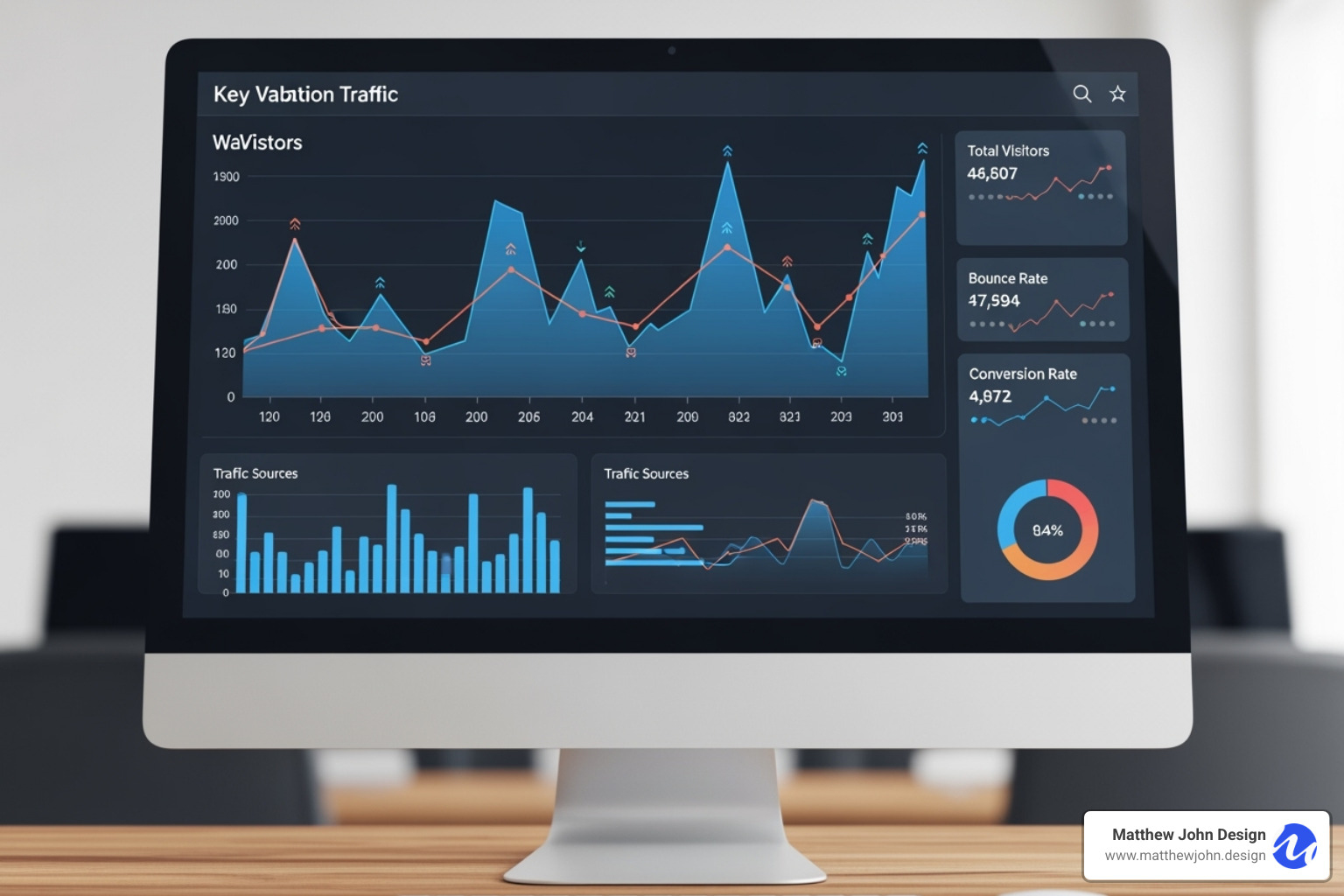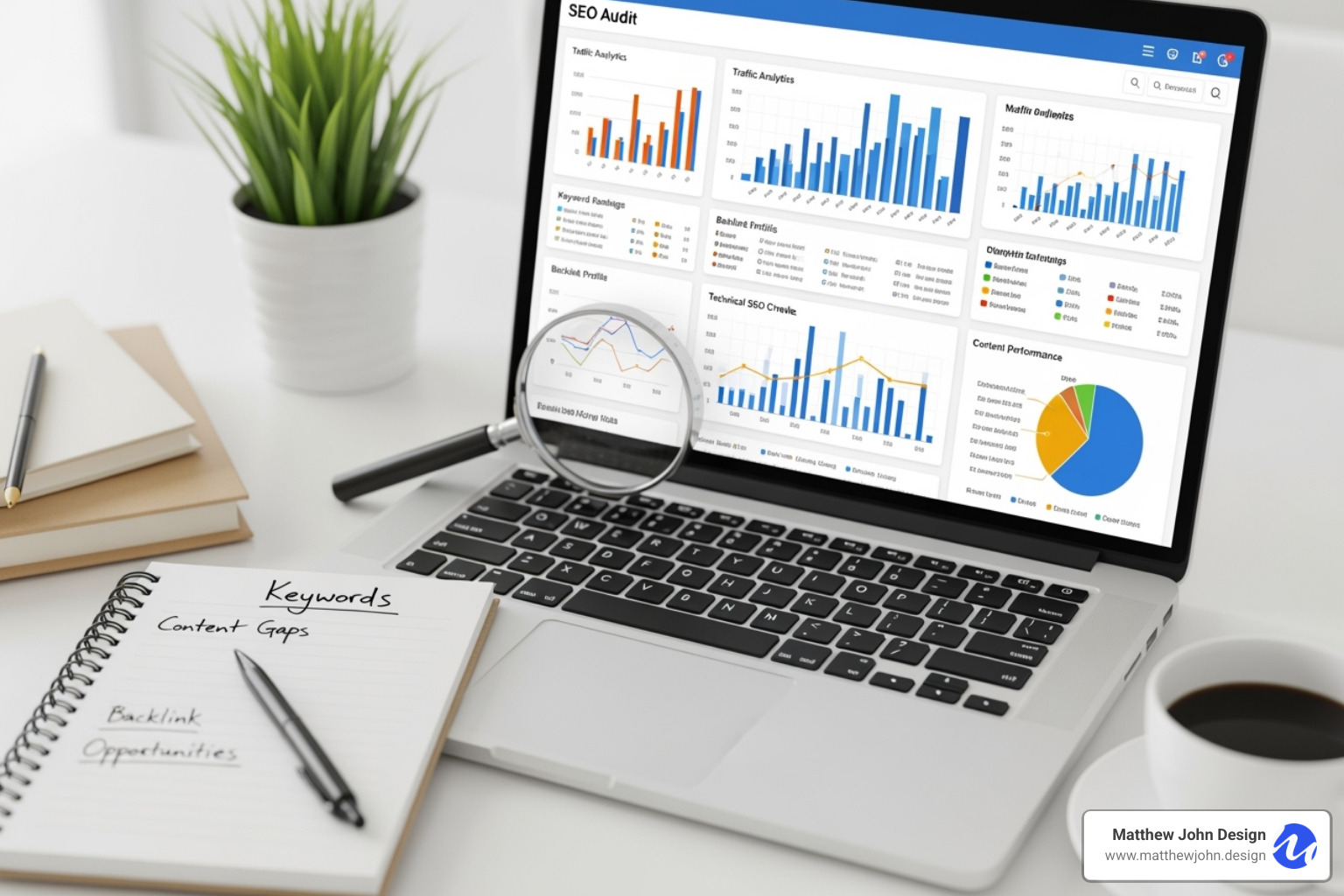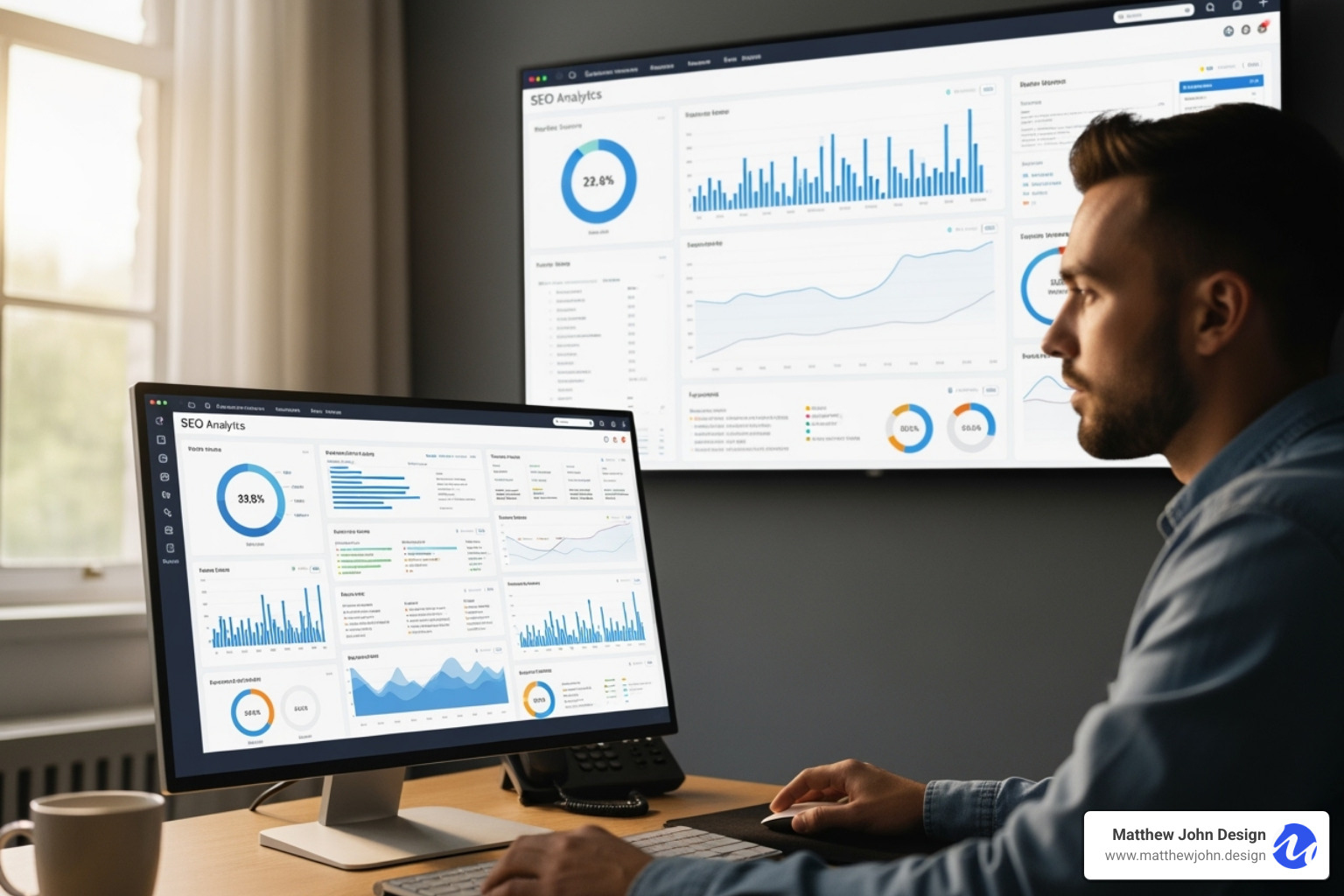Any information contained on this Website is not legal advice and should not be treated as such. You should always contact an attorney for help with your specific legal needs and issues. We may also earn a commission when you click links to our partners and purchase goods or services. For more information, read our Disclaimers Policy.
Why Every Website Needs a Comprehensive SEO Audit
Why Every Website Needs a Comprehensive SEO Audit
A comprehensive SEO audit is a check‑up for your website. It looks at technical health, content quality, user experience and off‑page signals to find growth opportunities.
Most pages on the web get no organic traffic. An audit helps you avoid being invisible by uncovering issues that stop search engines from finding, understanding or ranking your pages.
What an audit covers
- Technical SEO: crawlability, speed and security.
- On‑page optimisation: titles, meta descriptions and content structure.
- Content quality: relevance and gaps.
- Off‑page factors: backlinks and authority.
User experience: Core Web Vitals and mobile usability.
Technical SEO analysis (crawlability, site speed, security)
- On-page optimization (title tags, content structure)
- Content quality assessment (relevance, gaps)
- Off-page evaluation (backlink profile, domain authority)
- User experience audit (Core Web Vitals, mobile usability)
The reality is that 90.63 percent of content gets no organic traffic from Google. This is often due to underlying SEO issues that prevent search engines from finding, understanding, or ranking pages.
An SEO audit is a health check for your website, diagnosing problems before they kill your rankings. A single technical issue can tank traffic, while fixing critical problems can lead to dramatic improvements in visibility and conversions. For businesses, an audit is both a diagnostic tool and a strategic roadmap, revealing why competitors outrank you and creating a prioritized action plan for sustainable growth.

The 5 Pillars of a Comprehensive SEO Audit
A comprehensive SEO audit examines your website through five interconnected pillars that create a strong online presence. Technical issues can undermine great content, while poor user experience can waste the benefits of strong backlinks. Let's explore these pillars.
Technical SEO: The Unseen Foundation
Your site's technical foundation is critical. If it's solid, search engines can easily find, understand, and index your content. Key areas include:
- Crawlability: Your
robots.txtfile must allow search bots to access important pages. - Indexability: Ensure valuable pages don't have a
noindextag preventing them from ranking. - Site Speed: Slow sites frustrate users and signal a poor experience to search engines.
- Security: HTTPS is a confirmed ranking factor and essential for user trust, as noted in Google search essentials.
- Mobile-Friendliness: Google's mobile-first indexing means your mobile site's performance is paramount.
On-Page & Content SEO: Optimizing for Users and Search Engines
This pillar bridges the gap between search engine algorithms and valuable content for people.
- Title Tags & Meta Descriptions: Your title tags are headlines in search results, while meta descriptions are your pitch to earn a click. Google rewrites meta descriptions 62.78 percent of the time, so crafting good ones is key.
- Header Structure & Keywords: A logical header structure (H1, H2, etc.) helps users and search engines understand your content. Modern SEO focuses on covering topics comprehensively, not just keyword stuffing.
- Content Issues: Avoid thin, surface-level content. Address keyword cannibalization, where multiple pages compete for the same terms.
Off-Page SEO: Building Authority and Trust
Off-page SEO is about building your site's reputation across the web.
- Backlinks: Links from authoritative, relevant websites are powerful endorsements. The quality of linking domains is more important than quantity.
- Local SEO: For local businesses, an accurate and complete Google Business Profile is crucial. Ensure your Name, Address, and Phone number (NAP) are consistent across all online directories.
- Link Management: Your anchor text should be natural and varied. When linking out, be sure to qualify your outbound links to Google correctly.
User Experience (UX): Keeping Visitors Happy
Search engines prioritize sites that provide excellent experiences.
- Core Web Vitals: These metrics quantify user experience. They include Largest Contentful Paint (LCP) for loading speed, First Input Delay (FID) for interactivity, and Cumulative Layout Shift (CLS) for visual stability.
- Mobile Usability & Navigation: Your site must be intuitive and fast on mobile devices. A logical navigation structure helps users and search engines find content easily.
Pre-Audit Prep: Benchmarking for Success
Before starting, you must benchmark your performance to measure success later. This phase is about understanding where you stand now so you can prove the value of your efforts.

First, set clear goals. Are you trying to recover from a traffic drop, outrank a competitor, or prepare for a product launch? Your goal will guide the audit.
Next, identify key performance indicators (KPIs) that connect to your business goals. Track these essential metrics:
- Organic traffic
- Keyword rankings for important terms
- Click-through rate (CTR) from search results
- Conversion rate from organic visitors
Finally, benchmark your current performance using at least 12-18 months of historical data. Use Google Analytics to analyze traffic trends and user behavior, and Google Search Console to see how Google views your site, including which queries drive traffic and any technical errors. This data provides a baseline to measure improvement against.
How to Conduct Your Comprehensive SEO Audit: A Step-by-Step Guide
With benchmarks set, follow this structured process to conduct your comprehensive SEO audit.
Step 1: The Technical Deep Dive
Examine your website's behind-the-scenes mechanics to ensure search engines can access and understand your content.

- Crawlability & Indexability: Check your
robots.txtfile to ensure it isn't blocking important content. Hunt fornoindextags on pages that should be ranking. - Sitemap & Architecture: Verify your XML sitemap is up-to-date and submitted to Google Search Console. A logical site architecture should make key pages accessible within 3-4 clicks from the homepage.
- Internal Links: Analyze your internal linking structure to ensure authority flows to important pages and to find any "orphan pages" with no links pointing to them.
- Performance & Usability: Use Google's Core Web Vitals report to measure LCP (aim for under 2.5 seconds), FID (under 100ms), and CLS (under 0.1). Use Google's Mobile-Friendly Test to check for mobile usability issues.
- Security: Confirm your site uses HTTPS correctly and is free of malware.
Step 2: A Comprehensive SEO Audit of On-Page and Content Quality
This stage focuses on what your visitors see and interact with.
- Keyword & Content Strategy: Map primary keywords to each page to avoid keyword cannibalization. Use a content gap analysis to find topics your competitors rank for but you don't.
- On-Page Elements: Optimize title tags for clarity and length. Review meta descriptions to encourage clicks, knowing that Google rewrites meta descriptions 62.78 percent of the time. Ensure a logical header hierarchy (H1-H6) and descriptive image alt text.
- Structured Data: Use a tool like Schema Validator to check that your Schema.org markup is correctly implemented to earn rich snippets in search results.
Step 3: Evaluating Your Off-Page Footprint
Assess your website's reputation across the internet.
- Backlink Profile: Analyze the quality and relevance of sites linking to you. Identify and address any toxic or spammy links that could harm your reputation.
- Competitor Gap: Study your competitors' backlink profiles to find high-quality link-building opportunities.
- Local SEO: For local businesses, optimize your Google Business Profile with complete and accurate information. Perform a citation consistency check to ensure your Name, Address, and Phone number (NAP) are identical everywhere online.
From Audit to Action: Creating Your SEO Roadmap
A comprehensive SEO audit is useless without a plan. This is how you turn insights into action.

First, interpret your findings and connect them to business impact. A slow page isn't just a technical flaw; it's a conversion killer.
Next, prioritize tasks using an impact vs. effort matrix. Focus on quick wins (high impact, low effort) first to build momentum. Group other items into major projects, fill-ins, and low-priority tasks.
Then, create an actionable plan. For each task, define what needs to be done, who is responsible, and how you'll measure success. This clarity ensures accountability and progress.
When presenting recommendations to stakeholders, translate technical jargon into business outcomes. Instead of "fix CLS issues," say "improve page stability to prevent lost sales from users clicking the wrong button."
Finally, use project management tools like Asana or Trello to assign tasks, set deadlines, and track your SEO roadmap to completion. By benchmarking before and measuring after, you can demonstrate the clear ROI of your SEO efforts.
Essential Tools for Your SEO Audit Toolkit
Even the most experienced SEO professionals need the right tools to conduct a truly comprehensive SEO audit. This digital detective kit helps you uncover hidden issues and see your site as search engines do.
For Technical & On-Page Auditing
- Screaming Frog SEO Spider: A desktop crawler that quickly finds broken links, redirect issues, and missing metadata across your entire site.
- Sitebulb: Offers advanced technical auditing with helpful visualizations for understanding site architecture and internal linking.
- Google Search Console: A free, essential tool that provides direct feedback from Google on your site's performance, index status, and health.
For Speed and Core Web Vitals
- PageSpeed Insights: Google's tool for analyzing page performance and Core Web Vitals, providing actionable suggestions for improvement.
- GTmetrix: Provides detailed waterfall charts to help you diagnose what's slowing down your page load times.
- WebPageTest: An advanced tool for testing from different locations and browsers to simulate real-world user experiences.
Leveraging AI for Deeper Insights
AI tools can accelerate your audit by processing large datasets and summarizing key findings.
- Automated Analysis: Use AI to identify trends and anomalies in crawl data or Google Search Console exports.
- Content & Summarization: Tools like ChatGPT Advanced Data Analysis and Google Gemini can help generate content briefs, analyze semantic keywords, and summarize critical issues from large reports.
Frequently Asked Questions about SEO Audits
Here are answers to common questions about conducting a comprehensive SEO audit.
How often should I perform a comprehensive SEO audit?
We recommend a major comprehensive SEO audit once a year. Supplement this with quarterly technical health checks to catch smaller issues. For immediate problem detection, set up automated monitoring through tools like Google Search Console. Always perform an audit after significant site changes, such as a redesign or platform migration.
Can I do an SEO audit myself?
Yes, you can. This guide and free tools like Google Search Console and PageSpeed Insights can help you find and fix many common SEO issues. However, complex technical problems, analyzing very large sites, or creating a strategic roadmap often benefit from an expert's experience. An expert can prioritize fixes based on business goals and help you avoid costly mistakes.
What's the difference between a technical audit and a content audit?
They are two critical parts of a comprehensive audit.
- A technical SEO audit inspects your site's foundation: can search engines crawl, index, and render it efficiently? It covers site speed, mobile-friendliness, security, and sitemaps.
- A content audit evaluates what users see: is your content high-quality, relevant, and optimized for the right keywords? It looks for thin content and issues like keyword cannibalization.
A technically perfect site with poor content won't rank, and great content on a broken site will never be found. A comprehensive audit addresses both.
Conclusion
A comprehensive SEO audit is not a one-time task but a continuous cycle: audit to find opportunities, implement improvements, and monitor the results. This ongoing process is the key to achieving sustainable organic growth in the face of algorithm updates and changing user behavior.
By systematically improving your technical foundation, on-page optimization, content quality, off-page authority, and user experience, you create a powerful synergy where each fix amplifies the others. This holistic approach turns your website into a high-performing asset.
At Matthew John Design, we build scalable Webflow sites designed to perform. We understand that a beautiful website is only effective if it can be found. Our expertise lies not just in development but also in ensuring your site has the strong SEO foundation needed to attract organic traffic.
When you're ready to uncover what's holding your site back and build a clear roadmap for growth, we're here to help.

.jpg)